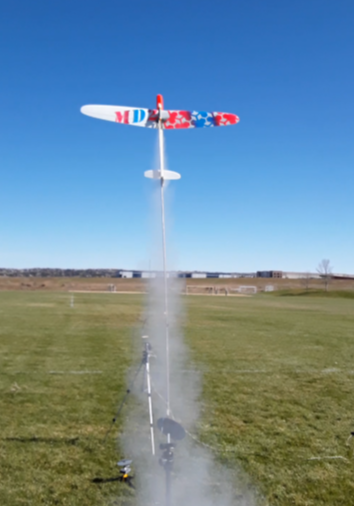What could be better than launching model rockets on Halloween?
Launching model rockets in near perfect weather on Halloween, of course.
Today's weather in the Metro Denver area proved to be very mild, with temperatures in the lower 60's and minimal windspeed levels.
Unfortunately, the launch had to be announced early in the morning, so the majority of our Front Range group of rocketeers found it too short of notice to be able to attend. As a result, only two of us were free to make the trip to Dove Valley - Jim Gazur and myself.
I started things off with a launch of my Estes Lynx. This flight marked a milestone in my model rocketry 'career' - the 200th flight of my BAR era. What better model to use than the first that came off the workbench when I resumed my 33-year hiatus from model rocketry!
Powered by an A10-3T motor, the model's 12th flight was picture perfect.
My next model to fly was the ol' Generic E2X.
Carrying a payload section containing both an Estes altimeter and a FlightSketch Mini, the model turned in a great flight on C6-5 power.
Jim Gazur's first flight of the session was the "Snowbird" on an Estes E12-4. Here is Jim's description of this rocket:
The Snowbird popped its parachute and came in for a nice landing near the launch pads.
Since the wind was at a minimum, I deemed it appropriate to try out a boost/glider. Out of the tote came the Flatcat.
Flying on a B4-2 motor, the bird boosted to a respectable altitude. Strangely, during coast phase the model's trajectory described a wide climbing circle. I had never seen this bird exhibit such behavior on past flights. It was usually straight up to apogee.
Nevertheless the model popped its parachute which hung up on the glider. Red Baron!
The Flatcat still descended rather slowly so there was no damage to any of the components.
Next, Jim brought out his big gliders.
The first to hit the skies was his Mini-Dart 2 Radio Control Rocket Glider conversion of a Discus Launch Glider.
The model flew on a Quest black powder C6-3.
In Jim's words: "I had been fighting elevator trim issues on this bird so I decided to ditch the moveable flaps and set everything neutral. The first flight was better in pitch but now there was a roll issue. Luckily the model slowed enough before hitting the ground that there was no damage."
Next up for my fleet was the Cherokee-E.
Flying on a D12-5, the model boosted to a very high altitude. Parachute deployment was perfect and the bird drifted down well within the park boundaries. I still haven't tried this one with an E motor yet - that might have to wait until I can get it to a larger field than Dove Valley.
Today, I had brought along a few smaller models that hadn't seen any air-time for awhile. The first of these was an Estes Super Shot - the 1990s version.
Flying on C6-5 power the model boosted great - until it reached the end of the launch rod!
After that it described cartwheels in very unstable flight across the Colorado blue, after which it dove in and took a core sample outside the launch area. The ejection charge blew the rocket off of the half-buried nose to end a wild and amusing flight.
Much to my surprise, the model sustained no damage whatsoever. Not even a scratch on the body tube. Later this week I must investigate why an Estes E2X model would go unstable in that manner.
Soon Jim had his MD-2 glider prepped and on the pad for its second flight of the day.
"The second flight boosted pretty well with some elevator input, but the glide revealed the need for a different flight condition setting for glide elevator trim. Regardless, I'm happy I finally made some progress on achieving a viable boost."
The other glider that Jim brought to fly this day was a Hawk Radio Control Rocket Glider conversion of a Discus Launch Glider, very similar to the MD2. He flew this one on on an Aerotech C3.4 18mm reload.
My final flight of the day went to the Griffin-2.
Carrying the Estes altimeter, the model boosted very straight and high on a C6-5 motor. The parachute deployed, bringing the model down unscathed after a little over a minute. The altimeter claimed 831 feet altitude.
With that done, Jim and I packed up and turned our footsteps homeward, having put up ten flights between us.
Even though two of my six flights were mishaps, none of the models flown today are destined for the 'repair shelf' back at the shop.
I'll take that any day...even on Halloween!
-Cheers...




















Thanks for showing us that you 2 could get it together and make it happen on a last-minute basis. I suspect it might be a while, but more will show next time around. Looked like a great day to fly. Fred
ReplyDeleteI sit here on a snowy evening hoping warm weather and blue skies return before too long! Hopefully see you at the field before too long!
ReplyDelete— Lee
I'm quite confident that we will have some stints of good rocket flying weather coming up in November and December. We'll definitely keep a close watch on windows of opportunity.
ReplyDelete